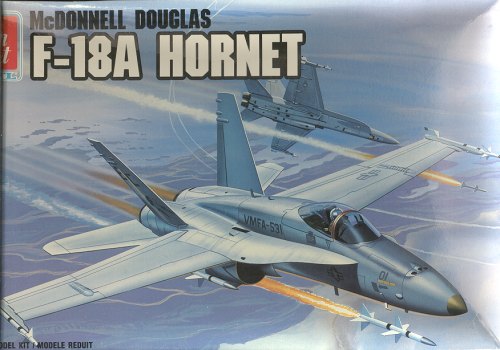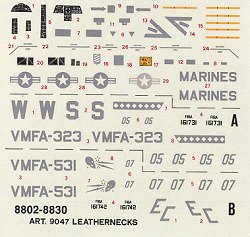
|
KIT: |
AMT 1/72 F-18A Hornet |
|
KIT # |
8802 |
|
PRICE: |
$6.00 (second hand) |
|
DECALS: |
two options |
|
REVIEWER: |
Scott Van Aken |
|
NOTES: |
ESCI kit #9047 reboxed by AMT |

|
HISTORY |
|
THE KIT |
As I mentioned in the stats box, this is nothing more than a reboxed ESCI F-18A kit. Though the box is dated 1988, the kit itself is actually several years older than that. It portrays an early F-18A before any of the patches were made to the fins and before the small 'finlets' were added above the wing strakes. This means that if build as it comes in the kit, it will have to be finished in one of the earlier schemes so check references to make sure it is properly painted. The kit instructions may not be the best when it comes to final finish.
So how about the kit itself. Well it is of the raised panel line variety, which is not surprising of a kit of this age. The breakdown of parts is not what one normally expects, especially if one has done a lot of Hasegawa or Fujimi kits in this scale. The nose section and forward lower fuselage is separate from the rest of the airframe. The wings are part of the upper fuselage and the aft section of the fuselage starts with the wheel wells. Intakes are always tricky on an F-18 and this one seems to be no exception and it is rather shallow as well. The intake lips themselves are sharp where the real Hornet intake is pretty much rounded. The lower strake sections are separate as are all the control actuator fairings and the forward fuselage missile rails.
Wheels are two part and really don't look that much like
Hornet wheels, being basically too 'pointy' where the tread meets the
road as well as too shallow. Wheel wells are basically devoid of any
detail though the landing gear isn't too bad if a bit simplified.
Missiles are equally unconvincing and though basically of a Sparrow and
Sidewinder shape, need replaced. There are no wing pylons and no wing
weapons. The exhaust nozzles are also rather oddly shaped and not very
convincing as belonging to a Hornet. My nose cone was short shot on the
tip so will need some epoxy putty to fix and get to a proper point.

Windscreen and canopy are separate parts. Cockpit detail it taken care of with decals for instrument panel and side consoles. This is quite typical of even more modern kits. The ejection seat is just a generic shape and truly needs to be replaced with something that looks more convincing. As I said, this is an old kit.
AMT instructions have always been rather good. This one is no exception with good color reference charts and lots of helpful info in the various construction steps. Markings are provided for two Marine aircraft. One is VMFA-323 and the other VMFA-531, two of the first USMC squadrons to get the Hornet. Both aircraft are block 10 aircraft and among the first 90 planes built. Decals are well printed and very glossy with rather thick carriers. I'm not sue how well they will work, but one has to at least use the instrument panel decals!
|
CONCLUSIONS |
I'd have to say that most modelers will not really be that interested in this kit. There are much better F-18s out there on the market, but this one has the benefit of usually being able to be found at a very cheap price (as I did on this one). Those who are inventive and just want to see what can be done with a less than cutting edge kit will want to give this one a try.
If you would like your product reviewed fairly and fairly quickly by a site that has over 200,000 visitors a month, please contact me or see other details in the Note to Contributors.